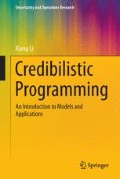Abstract
Distance between fuzzy quantities, used to represent the degree of difference, is a powerful concept in many disciplines of science and engineering. Within the framework of credibility theory, Liu gave an Euclidean distance based on the concept of expected value. Furthermore, Li and Liu proved the triangle inequality and the completeness of the fuzzy metric space. Based on the worst regret criterion, Li et al. proposed a fuzzy regret minimization model to minimize the distance between the fuzzy objective values and the best values. This chapter mainly introduces the concept of distance, regret minimization model, and applications in the portfolio selection problem.
Access this chapter
Tax calculation will be finalised at checkout
Purchases are for personal use only
References
Boxer L (1997) On Hausdorff-like metrics for fuzzy sets. Pattern Recognit Lett 18:115–118
Chaudhuri BB, Rosenfeld A (1996) On a metric distance between fuzzy sets. Pattern Recognit Lett 17:1157–1160
Chaudhuri BB, Rosenfeld A (1999) A modified Hausdorff distance between fuzzy sets. Inf Sci 118:159–171
Diamond P, Kloeden K (1990) Metric spaces of fuzzy sets. Fuzzy Sets Syst 35:241–249
Fan J (1998) Note on Hausdorff-like metrics for fuzzy sets. Pattern Recognit Lett 19:793–796
Inuiguchi M, Ramík J (2000) Possibilistic linear programming: a brief review of fuzzy mathematical programming and a comparison with stochastic programming in portfolio selection problem. Fuzzy Sets Syst 111(1):3–28
Inuiguchi M, Tanino T (2000) Portfolio selection under independent possibilistic information. Fuzzy Sets Syst 115:pp 83–92
Klement EP, Puri ML, Ralescu D (1986) Limit theorems for fuzzy random variables. Proc R Soc Lond Ser A 407:171–182
Li X, Liu B (2008b) On distance between fuzzy variables. J Intell Fuzzy Syst 19(3):197–204
Li X, Shou BY, Qin ZF (2012) An expected regret minimization portfolio selection model. Eur J Oper Res 218:484–492
Liu B (2004) Uncertainty theory: an introduction to its axiomatic foundations. Springer, Berlin
Puri ML, Ralescu D (1983) Differentials of fuzzy functions. J Math Anal Appl 91:552–558
Rosenfeld A (1985) Distances between fuzzy sets. Pattern Recognit Lett 3:229–233
Author information
Authors and Affiliations
Rights and permissions
Copyright information
© 2013 Springer-Verlag Berlin Heidelberg
About this chapter
Cite this chapter
Li, X. (2013). Regret Minimization Model. In: Credibilistic Programming. Uncertainty and Operations Research. Springer, Berlin, Heidelberg. https://doi.org/10.1007/978-3-642-36376-4_7
Download citation
DOI: https://doi.org/10.1007/978-3-642-36376-4_7
Publisher Name: Springer, Berlin, Heidelberg
Print ISBN: 978-3-642-36375-7
Online ISBN: 978-3-642-36376-4
eBook Packages: Business and EconomicsBusiness and Management (R0)

